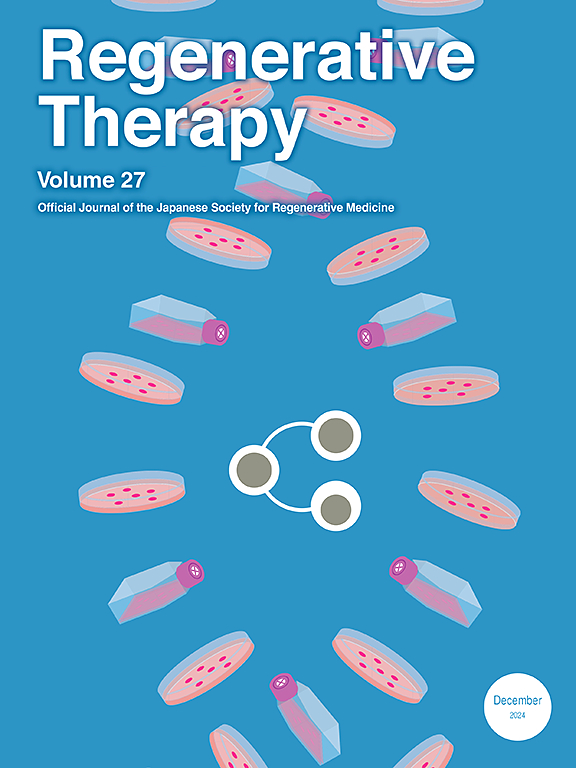人类ipsc衍生的脑类器官显示催产素介导的对淀粉样蛋白-β病理的保护作用
IF 3.5
3区 环境科学与生态学
Q3 CELL & TISSUE ENGINEERING
引用次数: 0
摘要
神经炎症是阿尔茨海默病(AD)发病的关键因素,小胶质细胞对淀粉样蛋白-β (a β)的清除受损与疾病进展密切相关。催产素(OXT)是一种下丘脑神经肽,最近被报道对小胶质细胞具有抗炎作用;然而,它在人脑中的治疗潜力尚不清楚。方法利用诱导多能干细胞(iPSCs)生成人脑类器官(hCOs),模拟早期ad样病理。3 μM a - β1 - 42作用48 h诱导Aβ毒性,通过免疫组织化学、RT-qPCR、钙显像和多电极阵列(MEA)记录评价OXT的保护作用。通过免疫染色和TREM2基因表达分析评估小胶质细胞在Aβ清除中的作用。结果sa β暴露导致hCOs外层Aβ显著沉积,并伴有神经活性抑制和凋亡信号通路增加。OXT预处理以浓度依赖的方式减弱a β沉积和caspase-3介导的细胞凋亡。经MEA测量,OXT还能恢复钙振荡和神经网络活动。值得注意的是,OXT增强了小胶质细胞对a β沉积物的募集,并上调了TREM2的表达,TREM2是小胶质细胞吞噬的关键调节因子。催产素受体(OXTR)在iba1阳性小胶质细胞上的共表达表明,OXT直接调节小胶质细胞的激活和Aβ清除。结论soxt对人皮质类器官具有神经保护作用,其机制是维持类器官的神经元活性,促进小胶质介导的Aβ清除。这项研究为OXT靶向AD患者的神经炎症和Aβ病理的治疗潜力提供了新的见解。本文章由计算机程序翻译,如有差异,请以英文原文为准。

Human iPSC-derived cerebral organoids reveal oxytocin-mediated protection against amyloid-β pathology
Introduction
Neuroinflammation is a key contributor to the pathogenesis of Alzheimer's disease (AD), and impaired clearance of amyloid-β (Aβ) by microglia is closely associated with disease progression. Oxytocin (OXT), a hypothalamic neuropeptide, has recently been reported to exert anti-inflammatory effects on microglia; however, its therapeutic potential in the human brain remains unclear.
Methods
We generated human cerebral organoids (hCOs) from induced pluripotent stem cells (iPSCs) to model early AD-like pathology. Aβ toxicity was induced by applying 3 μM Aβ1–42 for 48 h. The protective effects of OXT were evaluated through immunohistochemistry, RT-qPCR, calcium imaging, and multielectrode array (MEA) recordings. The involvement of microglia in Aβ clearance was assessed by immunostaining and gene expression analysis of TREM2.
Results
Aβ exposure led to significant deposition of Aβ in the outer layers of hCOs, accompanied by suppressed neural activity and increased apoptotic signaling. Pretreatment with OXT attenuated Aβ deposition and caspase-3-mediated apoptosis in a concentration-dependent manner. OXT also restored calcium oscillations and neuronal network activity as measured by MEA. Notably, OXT enhanced the recruitment of microglia to Aβ deposits and upregulated the expression of TREM2, a key regulator of microglial phagocytosis. Co-expression of oxytocin receptors (OXTR) on Iba1-positive microglia suggests that OXT directly modulates microglial activation and Aβ clearance.
Conclusions
OXT has neuroprotective effects on human cortical organoids by preserving their neuronal activity and promoting microglial-mediated Aβ clearance. This study provides novel insights into the therapeutic potential of OXT for targeting neuroinflammation and Aβ pathology in patients with AD.
求助全文
通过发布文献求助,成功后即可免费获取论文全文。
去求助
来源期刊

Regenerative Therapy
Engineering-Biomedical Engineering
CiteScore
6.00
自引率
2.30%
发文量
106
审稿时长
49 days
期刊介绍:
Regenerative Therapy is the official peer-reviewed online journal of the Japanese Society for Regenerative Medicine.
Regenerative Therapy is a multidisciplinary journal that publishes original articles and reviews of basic research, clinical translation, industrial development, and regulatory issues focusing on stem cell biology, tissue engineering, and regenerative medicine.
 求助内容:
求助内容: 应助结果提醒方式:
应助结果提醒方式:


